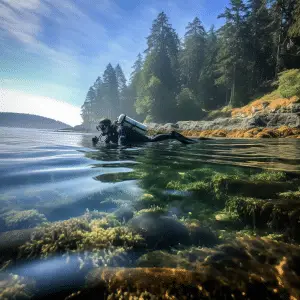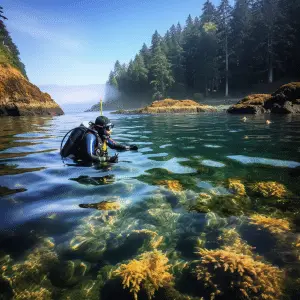With the Pacific Ocean to the west and north of the Strait of Juan de Fuca, the Olympic Peninsula is a treasure trove for scuba divers. The abundance of water bodies and the multiple underwater structures make it a great exploring area for avid scuba divers.
The waters in the area vary with the depth, making it a great diving experience for divers of all experience levels. It can be hard to find out the best places for scuba diving when visiting the Olympic Peninsula, but I am here to show you. Below is a list of four of the best places for scuba diving in the area.
1. Duncan Rock

Duncan Rock is not one for the weak-hearted. It is one of the more extreme dives with a diving depth of 80-95 feet. It is an intense dive surrounded by incredible structures that you can spend your time exploring. Only those who are extremely advanced in diving should go to this area as it is easier to get swept away by the strong currents.
Duncan Rock has also been featured as Top Pick for scuba diving in Olympic Peninsula in the article 5 Best Places for Scuba Diving in Washington State.
There are high winds and excessive swell that cause poor visibility, which can make it hard to make the dive. It is better to wait until the conditions are right before venturing out. Divers recommend going when the swell is a least 8 feet or even less on days with light wind.
You can reach the diving area by boat; using the boat will make it easier for you to judge the severity of the current and how strong the winds are. There are multiple canyons, spires, and walls that you should be careful of, but it will make you go back for more.
There are also plenty of invertebrates, such as crabs, and even rare sea life, such as yelloweye rockfish. Making this dive in the right condition is definitely worth it, as long as you are careful.
2. Sekiu Jetty
Sekiu Jetty is a great place for novice and intermediate divers. It has a short diving depth of only 30 feet and is seen as one of the best shore dives in Washington. The area boasts rich marine life on the kelp-covered rocks, such as the ling cod popular in the area, sea urchins, nudibranchs, octopuses, sea bass, and more. It is a great site to observe nature at its finest. You can also see species and fish that are not common in the area.
You can swim on the shore at night, although the visibility can be a little low. If you want to enjoy the scenery more, I suggest you go there during the day when there is enough light, and you can enjoy the sea animals.
The currents can run a little on the powerful side, so make sure you go there when the swell and wind are not too strong. The strong currents can lower the visibility, and you can only go down to 10 feet, and you will not be able to see much. You can reach the entry point by boat, although you can also swim there if you have the strength.
3. Mushroom Rock
Mushroom Rock is a much easier dive site than the others we have covered. It is found to the north of Cape Flattery. You can easily find it as it is marked by a mushroom-shaped rock that gives the island its name. The area’s rock outcrop, boulders, and channels keep the kelp beds shallow, improving visibility.
There is a wide array of invertebrates, such as red gorgonian corals, strawberry anemones, and lightbulb ascidians are some of the marine life you can see in the area. You can also spot some black-tip reef sharks and turtles in shallower water. Since the dive is not as deep as others, this is a great place to take your family; experienced younger divers can make this dive.
The visibility goes down to 30 feet on a day without strong currents or winds. More experienced divers can go down to 80 feet, but you will have to be careful. The north side has a wall that goes down about 50 feet until you reach a flat substrate. Follow this wall for at least 50 yards. You can see more interesting rock formations at this depth, with the boulders and rocks providing a habitat for marine life.
The current is relatively mild on a normal day which makes it easier to swim and dive. Consult the dive charts and let others know when you go, although it is not likely to get difficult current.
4. Lake Crescent

A gem of the Pacific North West, Lake Crescent is a beautiful lake close to the Olympic National Park. Locating the lake is easy; it is only 18 miles west of Port Angeles. Its beauty stands out in the crystal clear waters, making scuba diving in the area an adventure worth exploring.
The lake is known for its great visibility, especially during the summer. It has low nitrogen levels, keeping away weeds and other underwater plants, which is why the visibility is so high. Unlike most water bodies in Washington, Lake Crescent is warm, with temperatures going up to 65 degrees for the first 30 feet.
The lake is deep, going down to around 500 feet, although swimming down the first 50-100 feet is better. The visibility gets a little murky once you reach 30 feet, but you can still enjoy the abundance of marine life. The water also gets colder the lower you go, but it is still an interesting dive.
Last Words
scuba diving Olympic Peninsula, Whether you are looking for a new dive site, want to explore everything the Olympic Peninsula offers, or want to improve your diving skills, the four places above are the best option. They have everything, including shallow diving levels for those new to diving. The deeper waters and clear visibility in the area make exploration fun.
Remember to always consider your safety and consult the dive charts before heading out. You should also ensure you dive at your skill level, go out when the water is calm, or let someone else know that you are heading out and always stay safe.
